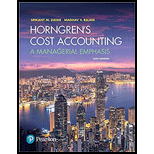
Concept explainers
Make versus buy, activity-based costing, opportunity costs. The Lexington Company produces gas grills. This year’s expected production is 20,000 units. Currently, Lexington makes the side burners for its grills. Each grill includes two side burners. Lexington’s
| Cost per Unit | Costs for 40,000 Units | |
| Direct materials | $8.00 | $320,000 |
| Variable direct manufacturing labor | 4.00 | 160,000 |
| Variable manufacturing |
2.00 | 80,000 |
| Inspection, setup, materials handling | 8,000 | |
| Machine rent | 12,000 | |
| Allocated fixed costs of plant administration, taxes, and insurance | 80,000 | |
| Total costs | $660,000 |
Lexington has received an offer from an outside vendor to supply any number of burners Lexington requires at $14.80 per burner. The following additional information is available:
- a. Inspection, setup, and materials-handling costs vary with the number of batches in which the burners are produced. Lexington produces burners in batch sizes of 1,000 units. Lexington will produce the 40,0 units in 40 batches.
- b. Lexington rents the machine it uses to make the burners. If Lexington buys all of its burners from the outside vendor, it does not need to pay rent on this machine.
- 1. Assume that if Lexington purchases the burners from the outside vendor, the facility where the burners are currently made will remain idle. On the basis of financial considerations alone, should Lexington accept the outside vendor’s offer at the anticipated volume of 40,000 burners? Show your calculations.
Required
- 2. For this question, assume that if the burners are purchased outside, the facilities where the burners are currently made will be used to upgrade the grills by adding a rotisserie attachment. (Note: Each grill contains two burners and one rotisserie attachment.) As a consequence, the selling price of grills will be raised by $48. The variable cost per unit of the upgrade would be $38, and additional tooling costs of $160,000 per year would be incurred. On the basis of financial considerations alone, should Lexington make or buy the burners, assuming that 20,000 grills are produced (and sold)? Show your calculations.
- 3. The sales manager at Lexington is concerned that the estimate of 20,000 grills may be high and believes that only 16,000 grills will be sold. Production will be cut back, freeing up work space. This space can be used to add the rotisserie attachments whether Lexington buys the burners or makes them in-house. At this lower output, Lexington will produce the burners in 32 batches of 1,000 units each. On the basis of financial considerations alone, should Lexington purchase the burners from the outside vendor? Show your calculations.
Learn your wayIncludes step-by-step video

Chapter 11 Solutions
EBK HORNGREN'S COST ACCOUNTING
Additional Business Textbook Solutions
Financial Accounting: Tools for Business Decision Making, 8th Edition
Engineering Economy (17th Edition)
Fundamentals of Management (10th Edition)
Microeconomics
Corporate Finance (4th Edition) (Pearson Series in Finance) - Standalone book
Foundations of Financial Management
- Principles of Accounting Volume 2AccountingISBN:9781947172609Author:OpenStaxPublisher:OpenStax College
 Cornerstones of Cost Management (Cornerstones Ser...AccountingISBN:9781305970663Author:Don R. Hansen, Maryanne M. MowenPublisher:Cengage Learning
Cornerstones of Cost Management (Cornerstones Ser...AccountingISBN:9781305970663Author:Don R. Hansen, Maryanne M. MowenPublisher:Cengage Learning Managerial Accounting: The Cornerstone of Busines...AccountingISBN:9781337115773Author:Maryanne M. Mowen, Don R. Hansen, Dan L. HeitgerPublisher:Cengage Learning
Managerial Accounting: The Cornerstone of Busines...AccountingISBN:9781337115773Author:Maryanne M. Mowen, Don R. Hansen, Dan L. HeitgerPublisher:Cengage Learning  Managerial AccountingAccountingISBN:9781337912020Author:Carl Warren, Ph.d. Cma William B. TaylerPublisher:South-Western College Pub
Managerial AccountingAccountingISBN:9781337912020Author:Carl Warren, Ph.d. Cma William B. TaylerPublisher:South-Western College Pub Financial And Managerial AccountingAccountingISBN:9781337902663Author:WARREN, Carl S.Publisher:Cengage Learning,
Financial And Managerial AccountingAccountingISBN:9781337902663Author:WARREN, Carl S.Publisher:Cengage Learning, Essentials of Business Analytics (MindTap Course ...StatisticsISBN:9781305627734Author:Jeffrey D. Camm, James J. Cochran, Michael J. Fry, Jeffrey W. Ohlmann, David R. AndersonPublisher:Cengage Learning
Essentials of Business Analytics (MindTap Course ...StatisticsISBN:9781305627734Author:Jeffrey D. Camm, James J. Cochran, Michael J. Fry, Jeffrey W. Ohlmann, David R. AndersonPublisher:Cengage Learning





